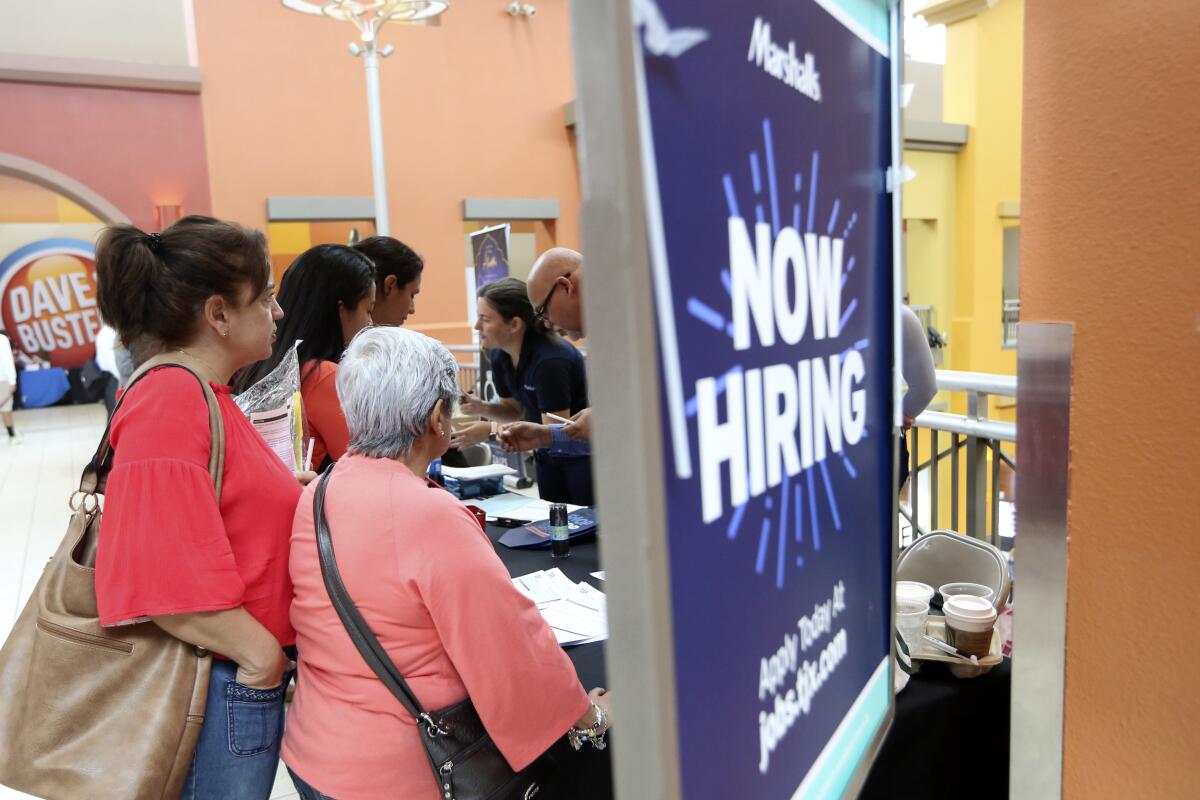U.S. economy creates 145,000 jobs, while unemployment holds steady at 3.5%

- Share via
U.S. employers added 145,000 jobs in December and the unemployment rate held steady at 3.5%, signaling that the job market remains strong at the start of 2020 even if hiring and wage gains have slowed somewhat more than a decade into an economic expansion.
Friday’s snapshot from the Labor Department showed hiring slipped from robust gains of 256,000 in November, which were given a boost by the end of a strike at General Motors Co. For the year, employers added an average of roughly 175,000 jobs per month, compared with about 223,250 per month in 2018.
Annual wage growth fell in December to 2.9%, down from an annualized average of 3.3% a year earlier, a possible sign that some slack remains in the labor market and that unemployment could fall even further from its current half-century low.
The picture of a slowly but steadily improving economy — plus low inflation — probably gives the Federal Reserve comfort in keeping interest rates low, which has been a boon to stock markets.
“We’re starting 2020 in very good shape,” said Gus Faucher, chief economist at PNC Financial Services. “We should see continued economic expansion throughout 2020 driven by consumers.”
The state of the job market has become a pivotal division between President Trump and his Democratic challengers. Trump can campaign on the low unemployment rate and job growth as he seeks a second term. Democrats, seeking to oust him, will point to wages that have not taken off in a meaningful way for many Americans coping with highs costs for medical care and higher education.
This is the last jobs report before the Iowa caucus in February that will serve as a first step for choosing the Democratic presidential nominee.
The prospects of a stable job market, a pickup in global growth, supportive central banks, an easing of trade tensions and U.S. economic growth of about 2% should be positives for this year.
“We really have the wind at our backs going into 2020,” said Julia Pollak, a labor economist at the employment marketplace ZipRecruiter.
Yet job growth has failed so far to translate into substantially better hourly pay. But there is the potential that wages jumped in January as many states adjusted their minimum wages.
Some businesses in competitive industries are already taking steps to prepare for wage competition this year. The Big Blue Swim School based in Chicago vies with day-care centers, learning centers and gyms for its instructors. The chain has five sites employing on average 30 people and plans to open five more schools this year and 17 in 2021. But it had to dramatically boost wages to attract staff for that expansion.
“We gave all of our front-line employees a 10% or 11% raise because of the fear we have about the wage pressures in the economy,” Chief Executive Chris Kenny said. “We can’t meet our business goal without great staff.”
Taco Bell announced Thursday that it would try to attract and retain workers by offering $100,000 salaries to restaurant managers in certain locations — a big increase compared with the $50,000 to $80,000 it usually pays for that job. The Irvine-based fast-food chain, owned by Yum Brands Inc., also announced it had begun offering paid sick time to its rank-and-file workers at company-owned restaurants.
Irina Novoselsky, CEO of the jobs site CareerBuilder, said that more employers are offering potential workers nonwage benefits such as the chance to work remotely and are becoming less focused on educational credentials when hiring.
“The major fact that is pushing the trend is the labor shortage in America,” she said. “Companies are being forced to provide that flexibility.”
The U.S. economy added 2.1 million jobs last year, down from gains of nearly 2.7 million in 2018. Hiring may have slowed because the number of unemployed people seeking work has fallen by 540,000 people over the last year to 5.75 million. With fewer unemployed people hunting for jobs, there is a potential limit on job gains.
The steady hiring growth during the expansion has contributed to gains in consumer spending. Retail sales during the crucial holiday shopping period improved 3.4% compared with the prior year, according to Mastercard SpendingPulse. This probably contributed to a surge of hiring in retail: That sector added 41,200 jobs in December.
The leisure and hospitality sector — which includes restaurants and hotels — grew by 40,000 jobs. Healthcare and social assistance accounted for 33,900 new jobs.
Still, the report suggests a lingering weakness in manufacturing.
Factories shed 12,000 jobs in December, after the end of the GM strike produced gains of 58,000 in November. Manufacturing companies added just 46,000 jobs in all of 2019.
Manufacturing struggled last year because of trade tensions between the United States and China coupled with slower global economic growth.
Safety problems at Boeing Co. have also hurt orders for aircraft and parts, and that could restrict hiring at factories in 2020. While the jobs report painted a healthy picture of the economy, the manufacturing sector took a blow Friday as Boeing supplier Spirit AeroSystems announced layoffs for 2,800 workers in Kansas.
More to Read
Inside the business of entertainment
The Wide Shot brings you news, analysis and insights on everything from streaming wars to production — and what it all means for the future.
You may occasionally receive promotional content from the Los Angeles Times.










